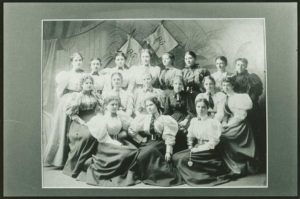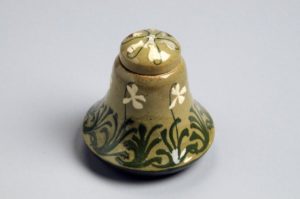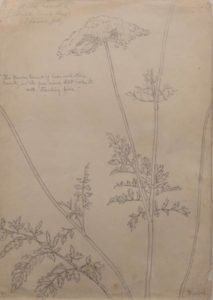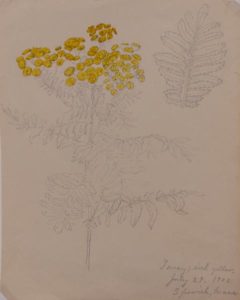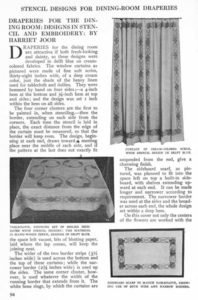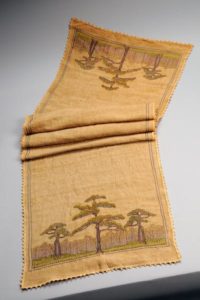Harriet Joor: Artist of Newcomb Pottery and Designer of the Arts and Crafts Movement
EMERGING SCHOLARS > EMERGING SCHOLAR LECTURES
Maggie Dimock,
Curator of Collections and Exhibitions, Alva de Mars Megan Chapel Art Center, Saint Anselm College
New Orleans’ Newcomb Pottery operated between 1895 and 1940 as a commercial offshoot of the art department at the H. Sophie Newcomb Memorial College. Established amidst a cultural and economic transitional period in the post-Civil War south, the Pottery’s founders aimed to showcase the talents of Newcomb art students while generating employment for young artists and designers trained in the College’s manual arts program and re-invigorating the culture of New Orleans.1 During nearly 50 years of operations, perhaps no other designer would come to more fully embody the aims of Newcomb Pottery than Harriet Coulter Joor (1875–1965). A talented and influential artist during her Newcomb years, Joor eventually established a successful independent career as an art instructor, professor, and freelance designer of ceramics and home furnishing textiles.
Founded in 1886, the H. Sophie Newcomb Memorial College was the country’s first women’s coordinate school, operating as the partner institution to Tulane University. The art department was headed by Ellsworth Woodward, an artist trained at the Rhode Island School of Design, and Gertrude Roberts Smith, a graduate of the Massachusetts Normal Art School. Inspired by the success of manual art and ceramic courses offered under the auspices of the Women’s Department at the World’s Industrial and Cotton Centennial Exhibition held in New Orleans in 1884–85, Woodward and Smith developed plans for an art pottery program at Newcomb College in 1893. Mary Given Sheerer, a graduate of the Cincinnati School of Design with ties to the Rookwood Pottery, was added to the faculty to teach courses in china painting and design, and ceramicists Jules Gabry and Joseph Fortune Meyer were hired to throw clay forms and oversee kiln operations. Guided by Arts and Crafts Movement principles emphasizing the virtues of handmade objects and the importance of the local and the vernacular, the organizers of the Newcomb Pottery encouraged experimentation and individuality among the ceramic artists, dictating only that decorative motifs be largely derived from plant and floral forms present in the Louisiana bayou region.
At the age of thirteen, Harriet “Hattie” Joor, the daughter of a botanist on faculty at Tulane, enrolled in art courses at Newcomb College’s preparatory school where she demonstrated a highly developed artistic aptitude and affinity for sketching plants and flowers. After graduating from the college in 1895, Joor enrolled as a “special art student,” joining the ranks of the earliest Newcomb Pottery artists. Between 1895 and 1900, Joor and her fellow ceramicists produced vessels using a range of techniques in surface decoration, reflecting the Pottery’s early experimental years. A small inkwell (Figure 2) Joor decorated in 1897 features a delicate design of violets executed using colored clay slips, a method that required painting onto an unfired vessel. This technique was later deemed too difficult to execute in the humid South and was abandoned in favor of painting onto fired bisque ware.2
At the turn of the century, the Pottery established a scholarship fund to send select Newcomb artists to a summer art program run by painter and educator Arthur Wesley Dow in the coastal town of Ipswich, MA. Dow was rapidly gaining a reputation as one of the most influential art instructors in the United States, following the publication of his design textbook Composition (1899), an educational treatise demonstrating various methods of achieving harmonious design through skillful arrangement of line, color, and notan, a Japanese term referring to masses of dark and light tones.
Joor was one of the first Newcomb women selected to attend Dow’s summer school, and made her first venture to Ipswich in 1900, returning at least once more in 1903. Later, she reflected on these sojourns as “wild and perilous journey[s] […] into the wide world,” a remark underscoring the sheltered circumstances of many Newcomb artists.3 Joor described the weekly curriculum at Ipswich as divided between two days of criticism interspersed with three days of design study and sketching wildflowers (Figures 3, 4). Students were also encouraged to engage in various craft activities, including weaving, woodblock printing, pottery, and basket-weaving, following Dow’s belief that truth in materials and excellent craftsmanship should fuel every artist’s work.4 The emphasis on varied craft disciplines at Ipswich may have inspired a similar diversification at Newcomb College. In 1902, new courses in needlework and metalwork were introduced to the art school curriculum, which would further expand to include bookbinding, leatherwork, and jewelry-making.
A three-handled tyg (Figure 5) decorated with a landscape of pine trees that Joor produced after her first summer in Ipswich is indicative of her internalization of Dow’s principles. The tyg’s design directly cites a space-filling exercise in Composition, in which a similar grove of trees is cropped in various ways to derive different rhythmic patterns from the repetitive verticality of the tree trunks (Figure 6). The trees are irregularly yet harmoniously distributed around the vessel, with heavily incised lines cut into the clay surface emphasizing the linear quality of the design. Areas of rougher cutting imbue the tree trunks with a sculptural quality, adding further visual and tactile interest.
Dow’s teaching style, which promoted analysis of the physical properties of working materials, may have inspired Joor to recognize the compositional benefit of incising the clay to heighten the effect of her design. Over the following decade, vessels decorated in this manner—with bold incised lines forming vertically banded spatial divisions, incorporating simplified plant forms and vibrant coloration under a clear glossy glaze—would come to dominate the artistic output of Newcomb Pottery. Only after 1910, when ceramic engineer Paul Cox introduced new satin and matte glazes to the Newcomb line, would the overall aesthetic of the Pottery begin to shift toward the hazy, atmospheric “moon and Spanish moss” bayou landscapes that became virtually synonymous with later Newcomb wares.
The opportunity to study with Dow, a major figure of early-20th-century American art, represented a high point in Joor’s training. Her time in Ipswich was also a crucial fulfillment of the ambitions of the Newcomb enterprise, which aimed to invest its artists with marketable skills to increase their prospects as professional designers. Traveling to New England and studying alongside other young artists from northern cities provided entrée into a potentially lucrative professional network. Connections forged in Ipswich with several artists from Chicago, including weaving and textile instructor Althea Harmer, likely helped Joor launch an independent career as an artist and educator. In 1905, she was hired to teach clay modeling classes at the University of Chicago’s Elementary School, an opportunity which may have arisen thanks to Harmer’s influence.5
Even while employed as a Newcomb Pottery artist Joor supplemented her income by publishing short stories and articles, first in local newspapers and, eventually, in nationally circulating popular magazines. After moving to Chicago, Joor increasingly depended on writing to support herself, often showcasing her talents for ceramic and textile design in instructional articles detailing the process and execution of simple handmade objects for the home (Figure 8). Her designs for stenciled curtains and slipcovers, embroidered bags and wearable accessories, and hand-built clay vessels were published in a variety of popular American shelter and women’s magazines including House Beautiful, Good Housekeeping, and Women’s Home Companion. She also maintained a private studio from which she taught art lessons and produced ceramic and textile work that she exhibited at the annual Art Craft exhibitions at the Art Institute of Chicago.
Among the most consistent of Joor’s publishing relationships between 1905 and 1910 was her steady role as a contributor to The Craftsman magazine overseen by Gustav Stickley, one of the chief American publications dedicated to promoting Arts and Crafts philosophy and design principles. Drawing on her experience in the Newcomb needlework studios, she designed and executed a series of embroidered linen table runners and centerpieces for publication in the magazine in 1907, featuring motifs of berries, trees, and conventionalized floral forms (Figure 9).6 These table coverings were eventually incorporated into Stickley’s commercial home furnishings line, and sold in shops and through Craftsman catalogs, finding their way into countless American homes (Figure 10).
Having left Louisiana, Joor would continue to forge a path into “the wide world,” with an adventurous stint as a homesteader in South Dakota in the early 1910s, followed by a period working as a teacher of therapeutic handicrafts to wounded World War I veterans at Walter Reed Hospital in Washington, DC. She eventually returned to Louisiana, settling in Lafayette, where she served for many years on the art faculty at Southwestern Louisiana Institute (now the University of Louisiana at Lafayette). From humble beginnings as a talented artist in the culturally isolated post-Civil War south, Harriet Joor became one of Newcomb’s most successful independent artists. Her achievements were a realization of the idealistic aspirations of the Newcomb Pottery enterprise, and she serves as a reminder of the textured histories of individuals responsible for shaping the aesthetic of the American Arts and Crafts Movement.
1
For a thorough account of the founding, operations, and varied craft products of the Newcomb Pottery enterprise, see Martin Eidelberg et al, The Arts & Crafts of Newcomb Pottery (New York: Skira Rizzoli, 2013).
2
This explanation for the rejection of colored clay slips in Newcomb Pottery decoration is detailed in Jessie Poesch and Sally Main, Newcomb Pottery and Crafts: An Educational Enterprise for Women, 1895–1940 (Atglen: Shiffer Publishing Ltd., 2003), 35.
3
In 1900 Joor attended the Ipswich Summer School with fellow Newcomb artist Amalie Roman. Her remarks describing the experience are recounted in an undated, unidentified article from a New Orleans newspaper pasted in a scrapbook now in the University Archives at the Howard-Tilton Library at Tulane University.
4
For more on the influence of Arthur Wesley Dow’s Ipswich Summer School, see Nancy E. Green et al, Arthur Wesley Dow: His Art and His Influence (New York: Spanierman Gallery, 1999), and Nancy E. Green and Jessie Poesch, Arthur Wesley Dow and American Arts & Crafts (New York: The American Federation of Arts, 1999).
5
Harmer was employed as a teacher at the University of Chicago’s innovative Laboratory School, founded by pioneering educational reformer John Dewey.
6
These needlework designs appear in The Craftsman vol. 13, no. 2 (November 1907), 221-228 in a recurring feature section titled “From the Craftsman Workshops,” and were printed alongside similar instructions and designs for home projects in metalwork. For the following issue, also in the “Craftsman Workshops” series, Joor designed a set of stenciled patterns for window curtains (see The Craftsman, vol. 13, no. 3 (December 1907), 348–352).

